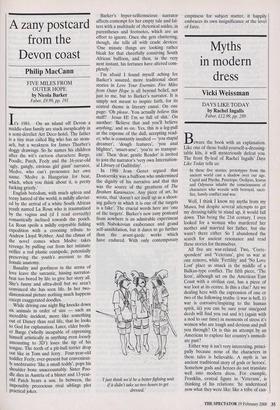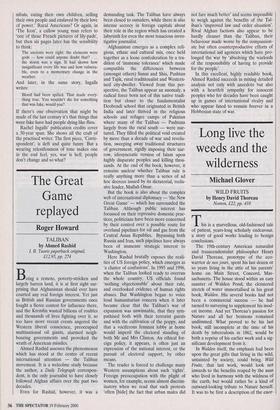Myths in modern dress
Vicki Weissman
DAYS LIKE TODAY by Rachel Ingalls Faber, £12.99, pp. 289 Beware the book with an explanation. Like one of those build-yourself-a-dressing- table kits, it will mysteriously defeat you. The front fly-leaf of Rachel Ingalls' Days Like Today tells us:
In these five stories, prototypes from the ancient world cast a shadow over our age. Cupid and Psyche, Penelope, Oedipus, Icarus and Odysseus inhabit the consciousness of characters who wrestle with betrayal, sacri- fice, family conflict and war.
Well, I think I know my myths from my Muses, but despite several attempts to get my dressing-table to stand up, it would fall down. This being the 21st century, I even looked for a woman who murdered her mother and married her father, but she wasn't there either. So I abandoned the search for ancient resonance and read these stories for themselves.
All five are war-related. Two, 'Corre- spondent' and 'Veterans', give us war at one remove, while 'Fertility' and 'No Love Lost' place us smack in the middle of a Balkan-type conflict. The fifth piece, 'The Icon', although set on the American East Coast with a civilian cast, has a piece of war loot at its centre. Is this a clue? Are we dealing here with the expression of one or two of the following truths: i) war is hell, ii) war is corrosive/inspiring to the human spirit, iii) you can be sure your sins/good deeds will find you out and iv) (again with a nod to our time) in moments of stress it's women who are tough and devious and pull you through? Or is this an attempt by an American to explore her country's immedi- ate past?
Either way it isn't very interesting, princi- pally because none of the characters in these tales is believable. A myth is 'an ancient traditional story of gods or heroes'. Somehow gods and heroes do not translate well into modern dress. For example, Franklin, central figure in 'Veterans', is thinking of his relations: 'he understood now what they were like: like a tribe of can- nibals, eating their own children, selling their own people and enslaved by their love of power.' Rural Americans? Or again, in `The Icon', a callow young man refers to `one of those French pictures of lily-pads', but then six pages later has the sensibility to think: The ancients were right: the elements were gods — how could anyone doubt that?
the storm was a sign. It had shown how insignificant every life was and how vulnera- ble, even to a momentary change in the weather.
And later, in the same story, Ingalls writes: Blood had been spilled. That made every- thing true. You wouldn't die for something that was fake, would you?
If there's one observation that might be made of the last century it's that things that were fake have had people dying like flies.
Rachel Ingalls' publication credits cover a 30-year span. She shows all the craft of the practised writer. The first piece, 'Corre- spondent', is deft and quite funny. But a wearing relentlessness of tone makes one in the end feel, yes, war is hell, people don't change and so what?



































































 Previous page
Previous page